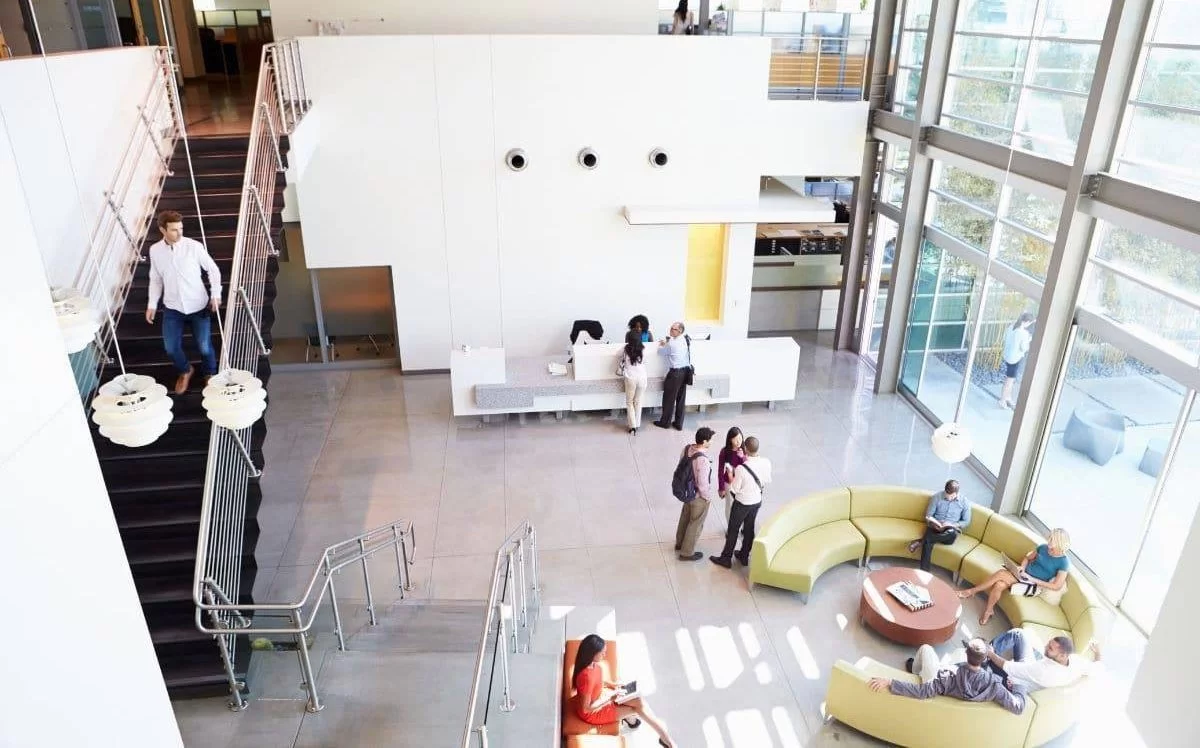
23 Mar 7 Modern Office Design Concepts To Attract The Best Employees
Activity-Based Working >
The Flexible Workplace >
Biophilic Design >
Home from Home >
Industrial Office Design >
Ergonomic Workstations >
Glass Walls And Doors >
As hybrid and flexible work models continue to grow, it’s more important than ever to design smart, adaptable workplaces that attract top talent and support long-term employee satisfaction. Without a doubt, the COVID-19 pandemic has changed the landscape of shared workplaces as we once knew them – but the future is still bright. Modern office design is evolving and shifting to fit the needs of post-pandemic working environments: hybrid and flexible workplaces, wellbeing-focused design and community-inspired spaces are taking storm in 2021. We’ve put together some of the most effective office design concepts that attract talent, boost productivity and make workplaces an enjoyable place for employees to thrive.
What can modern office design do for me?
Do you want to attract the crème de la crème of your sector? Are you competing for top talent in a hot job market? Is staff turnover a problem? These days, salary or financial compensation is just a small piece of the employee satisfaction puzzle. People need a workplace that stimulates creativity, collaboration, and communication while also reducing stress and anxiety.
What’s more, effective office design boosts productivity and guarantees real results for your business. Ideally you want a workplace that allows people to focus and concentrate whenever needed, and to collaborate and communicate whenever needed. You also want a workplace that is physically and mentally comfortable so that people can perform and function at their best. This is what today’s modern office design trends are striving to achieve.
This definitive guide is a list of the 7 most important office themes and design concepts that you need to know to attract and retain the best and most qualified employees to your organization. Let’s get started.
Ready to transform your office with modern design concepts? Contact us for a free consultation and start creating a workplace that attracts and retains top talent.
1. Activity-Based Working
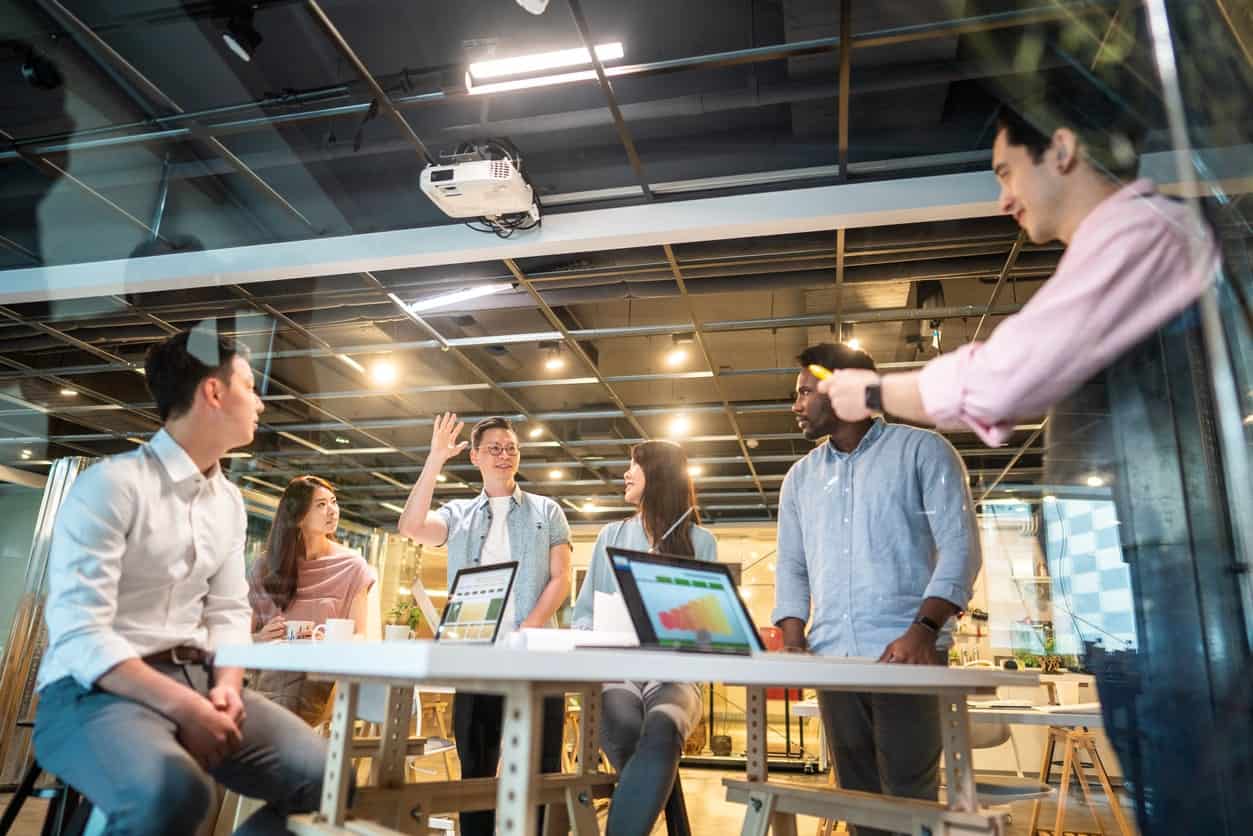
Flexible workplaces offer employees a fresh perspective during the workday, boosting productivity and creativity. Activity-Based Working (ABW) is designed to support diverse work styles, from focused tasks to collaborative sessions, ultimately improving employee well-being and company performance. It can get tiring spending all day in the same spot: sit-stand desks, privacy booths, shared desks and collaboration rooms can diversify the workplace and be the tonic your people need to boost their mood.
If an employee needs to do something that requires a high level of concentration and focus, he or she can move to an isolated quiet area to reduce distractions from co-workers. On the other hand, if an employee is doing something that requires close collaboration with co-workers, such as learning a new software application or overseeing a new employee, then he or she can sit at a traditional desk located immediately next to other co-workers in an “open communication” type of seating arrangement.
Here’s a breakdown of some of the different types of areas in an activity-based work environment:
Open Office Areas:
These are often the more traditional type of seating arrangement; where workers are seated very close to one another without any walls or cubicle barriers separating them. Typically, instead of each worker having his or her own individual desk, they share longer workbenches. where each worker has their own individual area and items on the workbench, such as a computer monitor, keyboard, mouse, landline phone, and other accessories.
Open office areas are suitable for highly collaborative work activities, such as activities where people may need to ask frequent questions of one another. Business areas such as sales, marketing and creative disciplines often utilize open-plan working areas to maximize on collaboration and communication benefits. There are some downfalls to this kind of working model though: noise, distractions and lack of privacy are noted as some of the problems. If confidentiality is important for your team, open-plan office areas offer little seclusion and might not be the best choice for you business.
Privacy Areas:
These are either small, enclosed, sound-proof booths or isolated quiet areas that allow a person to make confidential or private phone calls. These booths or areas may also be used to hold discreet meetings between two employees. Many private phone calls are totally unplanned and unscheduled. In those situations, an employee can quickly move to a private area immediately upon receiving a sensitive phone call from someone.
Quiet Focus Areas:
Distraction free areas are essential for concentration and maintaining focus. The type of setting can range from an isolated armchair or beanbag, to small independent workplaces and concealed soundproof rooms for ultimate concentration and privacy.
Meeting Areas:
Dedicated meeting rooms are often the springboard for creative thinking and idea sharing. Meeting areas come in all shapes and sizes and can be designed to suit the needs and objectives of your people. Whether it’s an enclosed room for privacy, a larger lounge area for comfort or a fusion of the two for enhanced collaboration and creativity.
Café Areas:
Whether it’s a brainstorming session, team meeting, lunch or just somewhere to grab a quick coffee – having diverse shared spaces available makes collaboration fluid and enjoyable for all.
Why Choose Activity-Based Working?
Activity-Based Working is a modern office solution that addresses the limitations of traditional office layouts by providing flexible spaces for different types of work. The Open Office Plan has been around for decades and was born in response to the problems of older and more traditional cubicles and private offices. With the open office plan, people work very closely together in open spaces with almost no barrier between them, with workers encountering inevitable distractions and noise from co-workers. The activity-based working model gives employees options to really diversify their workday through intelligent spatial design. So whether your people need quiet time, 1:1 discussion, group collaboration or a shared space to bounce ideas – activity-based working gives them options to choose a location that best suits their task.
2. The Flexible Workspace
Flexible workplaces have become a standard in modern office design, offering adaptable and reconfigurable workspaces to support collaboration and productivity. They feature desks, tables, and chairs that are easily movable and resizable, a bold advancement from the traditional office plan where the locations of desks, chairs, tables, and other resources are fixed and unchanging.
Flexible workplaces utilize modular designs that adapt to the evolving needs of teams. By offering easily adjustable desks, tables, and seating, businesses can foster greater collaboration, efficiency, and employee satisfaction. This allows meeting tables to be quickly resized to accommodate larger groups and for them to be more easily moved around on wheels. You can expect the dynamic creation of new teams and boosted collaboration between workers for short-term and long-term tasks.
Some flexible workplaces also feature unassigned seating arrangements. Put simply, employees aren’t assigned to a specific desk or workstation and can choose any space on each given workday. This concept has been boosted by the modern paperless workplace; where nearly all information is digitized by computer. As a result, the modern workplace is looking more and more like a simple desk and chair with only a computer, monitor, mouse, and keyboard. These factors allow for unassigned seating arrangements in the workplace to become more practical and easy to implement.
Unassigned seating is thought to enhance collaboration between employees, since today’s projects are becoming more dynamic and free-flowing. It’s also thought to enhance overall job performance, as some employees would like to work where they can best concentrate and focus on their work.
Google Garage is an exciting example of a flexible workplace. It’s a dynamic space where any Google employee can go to brainstorm new product ideas through hands-on experimentation with different physical products, devices, and gadgets such as 3D printers. Staff are encouraged to brainstorm ideas on tables and walls and all furniture, equipment and devices are on wheels! They’ve covered all bases and fitted power and ethernet cables to extend from the ceiling toward the floor so that full connectivity can be achieved from just about anywhere. Although you probably don’t have to go that far to provide a dynamic environment for your employees, Google Garage demonstrates how much smart spatial planning can achieve for aspirational businesses.
3. Biophilic Design
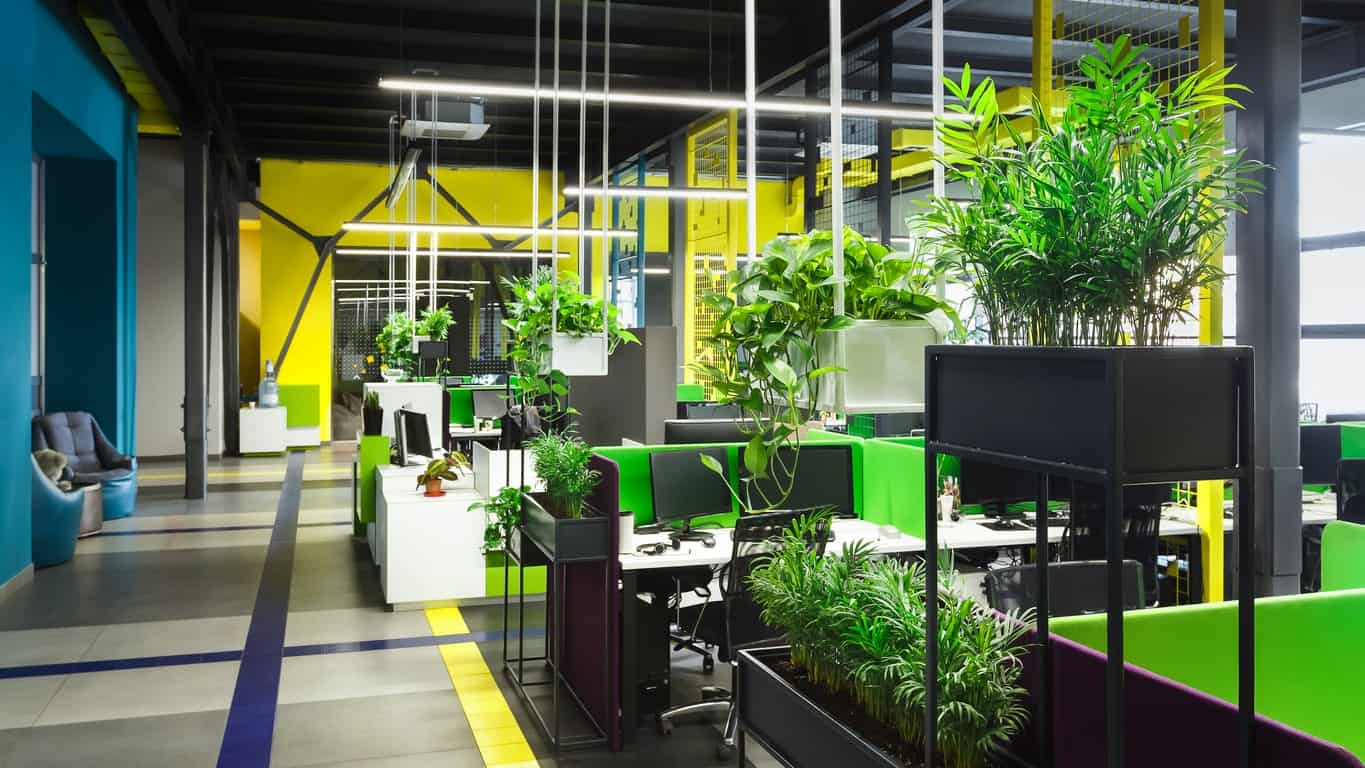
Biophilic design continues to gain traction, offering substantial benefits to both employee well-being and productivity. A green workplace has the power to boost moods, performance and wellness in your workplace. It’s based on the premise that humans have an innate need to connect with nature, and that when this connection is made, it results in better health, concentration, creativity, and work performance. Incorporating elements of the natural world have been proven to improve cognitive ability and reduce stress, blood pressure levels and heart rates in the workplace.
Biophilic design incorporates natural elements like sunlight, plants, and water features to enhance employee well-being, reduce stress, and boost productivity. Here are some biophilic design elements you can integrate into your workplace:
- Natural Light: Allow sunlight to stream into your space through high glass windows, glass walls, glass doors, and glass ceilings. High glass walls in lobbies and entrances have a positive, rejuvenating effect on the space.
- Flowing Water: Fountains, streams, and mini-waterfalls… although these examples might be over-the-top for many small offices, they provide a tranquil soundscape for lobbies, common areas, and large offices.
- Plants: Not only do they look gorgeous, plants improve air quality, boost ventilation and reduce toxin levels in the air. The aesthetic pleasure of gazing at plants and greenery is not to be underestimated!
- Views of Nature: If you’ve got green space outside, try to maximize your window space to make the most of the scenic views. Art work is another powerful way of invoking nature indoors: nature-themed paintings and prints work a treat! If you’re working with a larger space, indoor gardens with plants, trees, rocks, flowing water, and wooden bridges can be installed in building lobbies and common areas to provide views of nature.
- Natural Materials: Natural materials like wood or stone can bring a real raw aesthetic to your workplace, invoking the natural environment and bringing texture and contrast to traditional office design.
A great and shining example of biophilic design is the Central Atrium of the Federal Center South Building 1202 located in Seattle, Washington. This awe-inspiring building features a common area with natural light from high glass ceilings, gardens consisting of flowing waterways, trees and rocks, indoor plants and walls, stairs, and handrails made of reclaimed timber.
The modern trend toward biophilic design is so powerful, it is sweeping the world’s largest metropolitan areas from New York City to Singapore. Bloomberg LP, headquartered in midtown Manhattan, features extensive use of glass walls, glass doors, and fish tanks containing the world’s most exotic species of fish, on every floor of the headquarters building in Manhattan.
On building rooftops in midtown Manhattan can be seen gardens of trees, grass, and other elements of nature. Singapore began its biophilic movement about 50 years ago, where green natural surroundings can be seen everywhere. In fact, Singapore, which used to be called the “Garden City”, is now more appropriately called “City In A Garden”.
4. Home from Home
Creating a home-like office environment is a key design trend for 2025, where comfort and well-being are central to employee productivity and engagement. Think bright and comfortable sofas, recreational swings, ping-pong tables, lounge areas: the idea is to make the workplace as relaxing and stress-free as possible. By creating areas where employees can take short breaks to give their bodies and minds a rest, in turn allows them to recharge and remain productive throughout the day.

Cozy spaces aren’t all about downtime though: they can be a productive space too! Group meetings can be held at an informal living-room type of space with sofas, armchairs, and coffee tables. Collaborative spaces encourage a sense of togetherness, inclusivity and belonging amongst staff. If you build a positive office community, you’ll in turn promote positive work relationships and create a mutually supportive environment for staff.
Some of the home-like perks commonly provided by employers now include:
- Comfy sofas, armchairs, pod seats, and coffee tables
- Lounge areas
- Break areas with recreational games
- Cafés with free coffee, snacks, and food
- Fully-stocked bars
- Outdoor terraces and balconies
- Exercise gym and showers
- Bicycle storage
Can home-inspired workplaces improve employee performance?
The answer is yes!
Companies across the globe are discovering that providing a home-like atmosphere encourages productivity, collaboration, and open dialogue. After all, a home-like atmosphere is less intimating and less formal than a traditional office setup. In a relaxed setting, people feel more free to express their thoughts casually: stimulating brainstorming and creativity.
5. Industrial Office Design
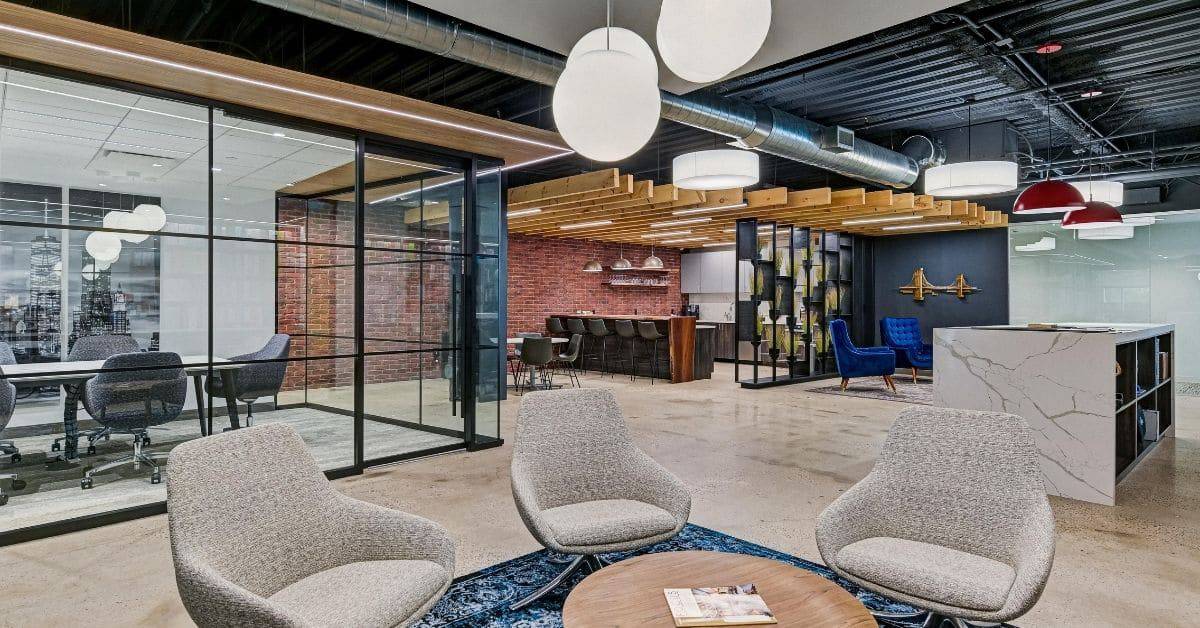
Industrial office design remains a popular and enduring choice for companies looking to foster creativity and a sense of openness in their workplace. The industrial office design is a purely aesthetic style of design that is intentionally unsophisticated and creates a raw, rustic, and unrefined atmosphere for office workers.
You’re probably used to seeing some of these popular industrial design trends:
- Exposed ceiling air ducts
- Exposed ceiling pipes
- Exposed ceiling beams
- High ceilings
- Exposed brick walls along the outside of the office space
- Lack of interior walls resulting in more open space
- Very large windows
- Natural wood instead of treated wood
- Concrete floors instead of wood or carpeted floors
- Overhanging light fixtures with exposed light bulbs
The popular industrial style promotes your business as unconventional, creative, rebellious, or outside the mainstream. It’s a bold step away from corporate luxury and is embraced by start-ups and companies with brand identities rooted in simplicity. The headquarters office space of Yelp! has been constructed with a bold industrial concept. Heroku’s San Francisco headquarters are fine example of a raw, unassuming and imperfect space – check it out!
From a practical standpoint, industrial office designs are generally more budget-friendly than other types of office design. But the savings in construction costs could be offset by potentially difficult technical challenges encountered while converting an old factory or industrial building into one that is fit for office use in a corporate setting. Remember, the type of office design used in your workplace determines what kind of employees you attract to your company or organization. The industrial office design tends to attract a younger demographic looking to exercise their creativity and unconventional way of thinking.
6. Ergonomic Workstations
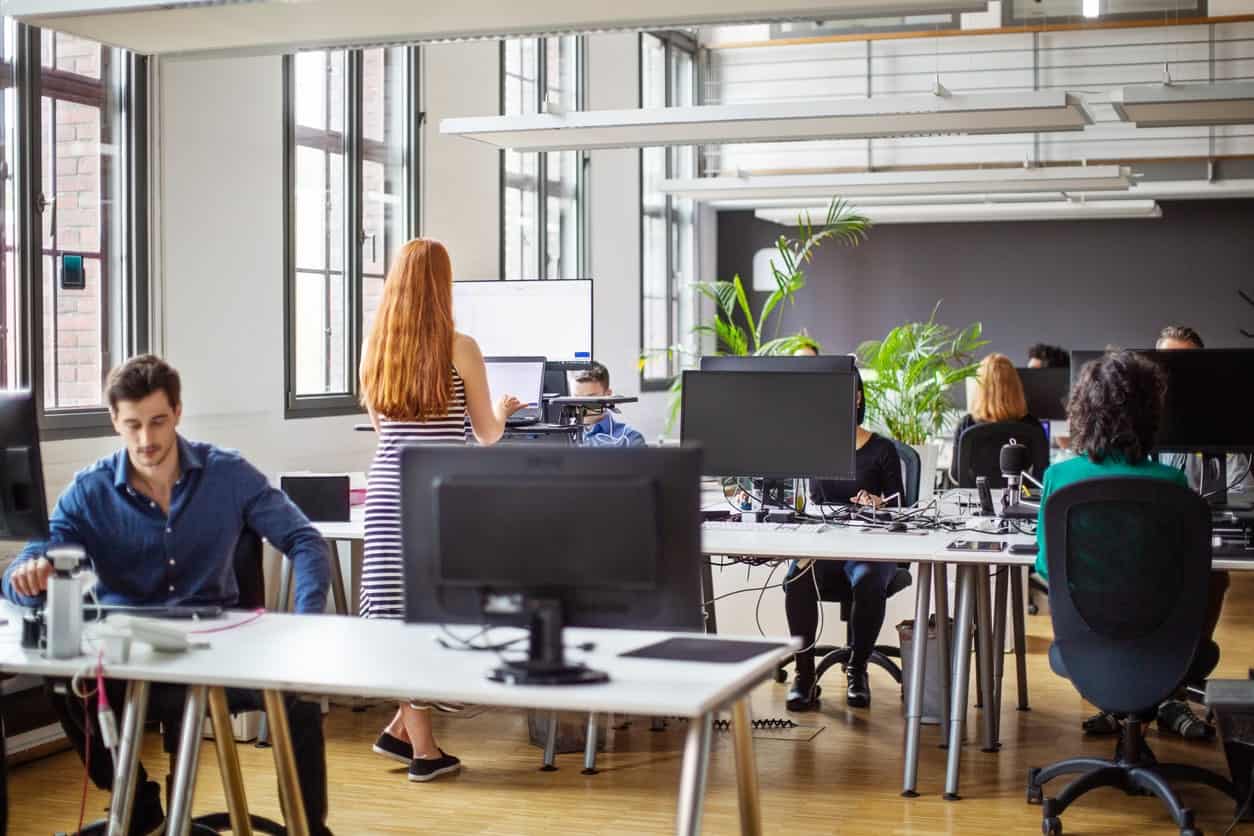
Given the growing concern over health and productivity, ergonomic workstations are crucial for ensuring employees remain comfortable and focused throughout their workday. To address this issue, today’s modern office workplaces are incorporating the following new technologies into their workstations:
- Ergonomic Chairs: These are office chairs that have adjustable support for your lower back, which is also called lumbar support. Their seat height should also be adjustable so that the person sitting on the chair has both feet planted firmly on the ground. The height of the armrests should also be adjustable.
- Height Adjustable Desks: Ideally you would want the height of the desk to be adjustable for people of different body sizes. Some people also like to alternate between sitting and standing while they work. These desks use electric motors to adjust their height upon button activation.
- Sit/Stand Desk Risers: Also called “standing desks”, these are height-adjustable mechanical platforms that sit on top of the desk on which is placed your monitor, keyboard, and mouse. They are suitable when the employee wants to alternate between sitting and standing while working.
- Exercise Ball Chairs: These are large plastic balls inflated with air that can be used instead of a chair. As exercise, the person sitting on the ball can bounce up and down on the ball. Sitting on the ball also forces you to exercise the muscles in your body that are required to maintain balance on the ball. However, the health benefits of exercise ball chairs remain controversial.
Some employees like to periodically alternate between sitting and standing at their desks in order to minimize the health risks associated with sitting for too long. But health benefits aside, the sit/stand technique along with the exercise ball chair can both stimulate thinking, creativity, and concentration in some people, since the mind and body are interconnected.
7. Glass Walls And Doors
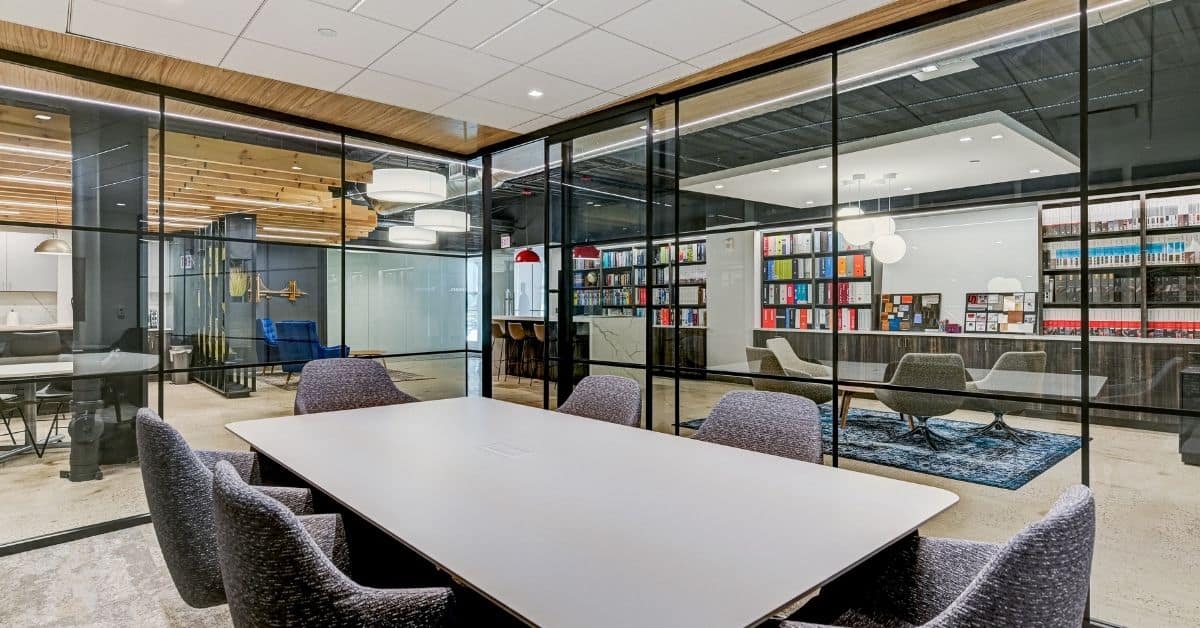
Glass walls and doors have become a staple in modern office design, offering benefits like increased natural light and a more open, collaborative atmosphere.
There are two main benefits of having glass walls and doors in the workplace:
1. Natural Light.
It’s impossible to understate the power of natural light! Bright spaces are not only energizing, they reduce eye strain and potential headaches too. Utilizing spaces that avail of the most natural light is important, so your design scheme should take into account the brightest spaces and how they can be best used to support the wellbeing of your people.
A study published by American Academy Of Ophthalmology shows a strong link between the development of near-sightedness (also known as myopia) and the number of hours spent outdoors per week [1].
Another study shows that as we age, our eyes lose the ability to absorb blue light, and that this is responsible for health problems [2]. It turns out that blue light, which is part of natural daylight, is required for the production of melatonin, a hormone that is responsible for healthy, restful sleep and the rejuvenation of our bodies during sleep at night. Without it, we lose our biological rhythms based on the 24-hour cycle, and this can lead to health problems.
2. Transparency.
Glass walls and doors promote more transparency in the workplace and a positive community-feel in the workplace. Whilst being relatively sound-proof, so they still allow people to concentrate and focus on their work. Some of the most inventive office design schemes make extensive use of glass and it’s easy to see why!
It’s also worth noting that glass walls are often cheaper, providing a brighter and bigger floor space and square footage at a fraction of the cost of normal walls.
How can office design trends help me attract the best employees?
We all spend a lot of time at work, so it’s worth investing in strategically planned workplaces that are comfortable, collaborative and enjoyable places to be. When considering office design trends, it’s always important to consider how they’ll impact on your employees’ motivation, health, and productivity, but also the cost of implementing those elements. RI Group focus on what works best for your people: we’re here to help your business make design-led, smart choices for your wellbeing in your space.
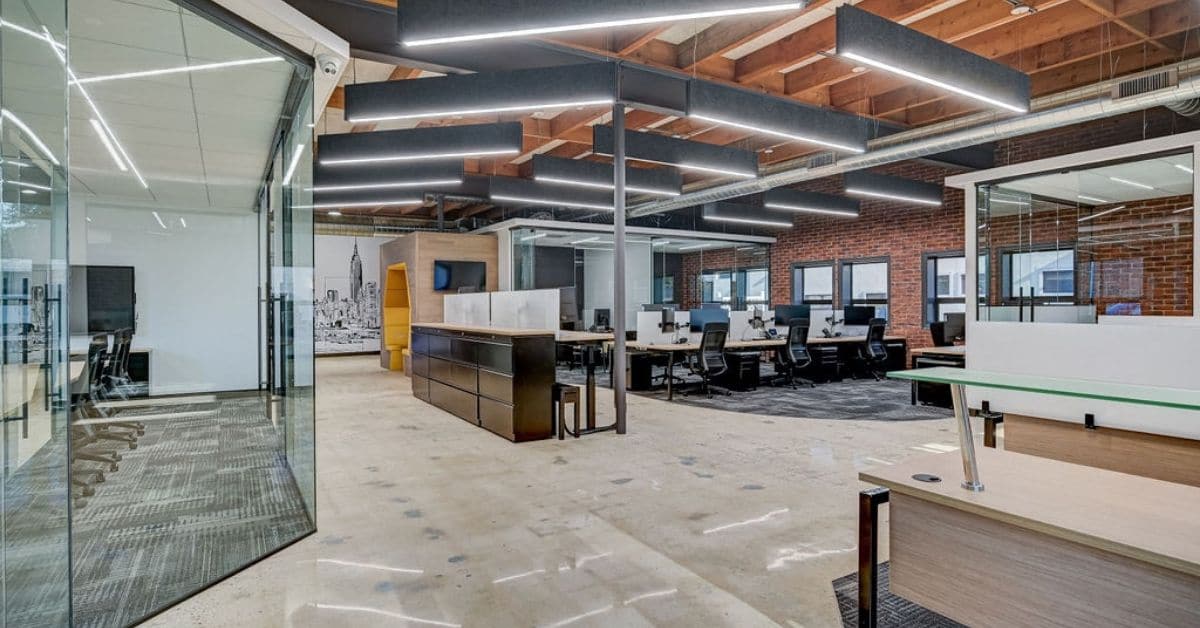 A Modern Office Design by us at RI Group
A Modern Office Design by us at RI Group
Want to Learn More?
RI Group will dig deep to understand the dynamic of your workplace and culture. That way, we can deliver effective, collaborative solutions and people-inspired design spaces bespoke to your company and vision. We’re here to help you make the right decisions for your people! If you have any questions, we want to hear them.
Get in touch and we’ll find the perfect solution for your business.
References
[1] http://www.aaojournal.org/article/S0161-6420(12)00363-6/abstract
“The Association between Time Spent Outdoors and Myopia in Children and Adolescents”
(American Academy Of Ophthalmology, October 2012, Volume 119, Issue 10, Pages 2141–2151)
[2] http://bjo.bmj.com/content/92/11/1439.full
“Circadian photoreception: ageing and the eye’s important role in systemic health”
(British Journal of Ophthalmology, Volume 92, Issue 11)
[3] http://journals.sagepub.com/doi/abs/10.1177/096032718902100102
“Fluorescent lighting, headaches and eyestrain”
[4] https://www.tandfonline.com/doi/abs/10.1080/001401398186928
“The impact of flicker from fluorescent lighting on well-being, performance and physiological arousal”
(Ergonomics, 1998, Volume 41, Issue 4)
[5] http://journals.sagepub.com/doi/abs/10.1177/14771535950270040301
“Modulation of fluorescent light: Flicker rate and light source effects on visual performance and visual comfort”
[6] https://en.wikipedia.org/wiki/Laminated_glass
“Laminated glass”




















